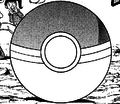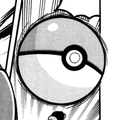Poké Ball (item): Difference between revisions
m (→In the TCG) |
(→In spin-off games: +info from TCG video games) |
||
| Line 267: | Line 267: | ||
Finally, Poké Balls can be included in limited-time Box deals. | Finally, Poké Balls can be included in limited-time Box deals. | ||
===In the Pokémon Trading Card Game series=== | |||
In {{ga|Pokémon Trading Card Game}} and [[Pokémon Card GB2: Here Comes Team GR!]], there are no Poké Balls. However, the {{OBP|Poké Ball|Jungle 64}} card is available in both games. | |||
{| style="margin:auto; text-align:center; {{roundy|10px}} border: 2px solid #{{Poké Balls color dark}}; background: #{{Poké Balls color}}" | |||
| style="{{roundy|10px}} border: 2px solid #{{Poké Balls color dark}}; background: #{{Poké Balls color light}}; width:80px; height:20px" | [[File:TCG1 A42 Poké Ball.png]] | |||
| style="{{roundy|10px}} border: 2px solid #{{Poké Balls color dark}}; background: #{{Poké Balls color light}}; width:80px; height:20px" | [[File:TCG2 C59 Poké Ball.png]] | |||
|- style="font-size:80%" | |||
| {{color2|000|Poké Ball (Jungle 64)|Poké Ball}} ({{color2|000|Pokémon Trading Card Game (game)|GB1}}) | |||
| {{color2|000|Poké Ball (Jungle 64)|Poké Ball}} ({{color2|000|Pokémon Card GB2: Here Comes Team GR!|GB2}}) | |||
|} | |||
===In the Pokémon Pinball series=== | ===In the Pokémon Pinball series=== | ||
In [[Pokémon Pinball]] and [[Pokémon Pinball: Ruby & Sapphire]], the Poké Ball is the normal ball used in Pinball games since the beginning of the game. It has no bonus multiplier, but it can be upgraded into other types of Poké Ball that multiply bonus points. | In [[Pokémon Pinball]] and [[Pokémon Pinball: Ruby & Sapphire]], the Poké Ball is the normal ball used in Pinball games since the beginning of the game. It has no bonus multiplier, but it can be upgraded into other types of Poké Ball that multiply bonus points. | ||
{| style="margin:auto; text-align:center; {{roundy|10px}} border: 2px solid #{{Poké Balls color dark}}; background: #{{Poké Balls color}}" | {| style="margin:auto; text-align:center; {{roundy|10px}} border: 2px solid #{{Poké Balls color dark}}; background: #{{Poké Balls color}}" | ||
| style="{{roundy|10px}} border: 2px solid #{{Poké Balls color dark}}; background: #{{Poké Balls color light}}; width:80px; height:20px" | [[File:Pinball Poké Ball.png]] | | style="{{roundy|10px}} border: 2px solid #{{Poké Balls color dark}}; background: #{{Poké Balls color light}}; width:80px; height:20px" | [[File:Pinball Poké Ball.png]] | ||
Revision as of 09:34, 5 January 2020
| |||||||||||||||||||
| |||||||||||||||||||
| |||||||||||||||||||
The Poké Ball (Japanese: モンスターボール Monster Ball) is a type of Poké Ball introduced in Generation I. It is the most basic form of Poké Ball, an item used to catch a wild Pokémon.
The eponymous Poké Ball is the most ubiquitous kind of Poké Ball across the entire Pokémon franchise. It is frequently used to represent the Pokémon series as a whole, such as in the Pokémon series' icon in the Super Smash Bros. series.
In the core series games
Price
|
- In Pokémon Crystal, during a Rooftop Sale at the Goldenrod Department Store, Poké Balls can be bought for $150 each.
- In Pokémon Black, Poké Balls can be bought in Black City's Marketplace for $10000 each if Rich Boy Pierce is present in the city.
Effect
Manual activation
When used from the Bag in a wild Pokémon encounter, it will attempt to catch the wild Pokémon with a catch rate modifier of 1×.
If used on an Ultra Beast, the catch rate modifier is instead set to 0.1×.
The Poké Ball cannot be used in situations in which Poké Balls cannot be used, such as in wild battles with two or more opponents currently present or against a trial Pokémon. If used in a Trainer battle (except if used as a Snag Ball on a Shadow Pokémon), the opposing Trainer will deflect it, wasting the ball. If used on the ghost Marowak, it will dodge it, wasting the ball.
Held item
Fling fails if the user is holding an Poké Ball.
Outside of battle
From Generation IV onwards, if in Bag when Nincada evolves into Ninjask, adds a Shedinja to the party provided the player has room in their team.
Exchange
Generation V
In Pokémon Black, White, Black 2, and White 2, on weekends, 20 Poké Balls can be exchanged for a Full Restore at Anville Town.
In Pokémon Black 2 and White 2, once per day, a Poké Ball can be exchanged for a Great Ball at with a Roughneck at Virbank Complex.
Generation VI
In Pokémon X and Y, once per day, a Poké Ball can be exchanged for a Dive Ball in Ambrette Town.
Description
|
Acquisition
Cameo appearances
In the core series games prior to Generation VII, as well as in Pokémon: Let's Go, Pikachu! and Let's Go, Eevee!, all NPC Trainers keep their Pokémon in standard Poké Balls. The same also applies to the Pokémon Stadium games, Pokémon Colosseum, Pokémon XD: Gale of Darkness, and Pokémon Battle Revolution.
Due to games not keeping track of which Poké Ball a Pokémon was caught with prior to Generation III, the player's Pokémon are also always sent out from standard Poké Balls in the Stadium games.
Pokémon Stadium 2
In Pokémon Stadium 2, Poké Balls appear in the mini-game Furret's Frolic. They are worth one point each.
Pokémon Sun, Moon, Ultra Sun, and Ultra Moon
In Pokémon Sun, Moon, Ultra Sun, and Ultra Moon, the following Trainer classes keep their Pokémon in standard Poké Balls:
- Backpacker
- Beauty
- Bellhop
- Cook
- Hiker
- Janitor
- Office Worker
- Preschooler
- Sightseer
- Trial Guide
- Trainers who share the same model as any of the above (e.g. Flareon User and Teacher)
Additionally, Hau, Professor Kukui, Red, and Blue keep their Pokémon in standard Poké Balls.
Pokémon Sword and Shield
In Pokémon Sword and Shield, the following Trainer classes keep their Pokémon in standard Poké Balls:
- Backpacker
- Black Belt
- Cabbie
- Café Master
- Cameraman
- Lass
- League Staff
- Macro Cosmos's (excluding Chairman Rose)
- Office Worker
- Poké Kid
- Police Officer
- Reporter
- Schoolboy
- Schoolgirl
- Worker
- Youngster
- Gym Trainer (Turffield)
Additionally, Hop, Morimoto, and all the NPC Trainers at the Battle Tower keep their Pokémon in standard Poké Balls.
Appearance
Artwork
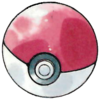
|
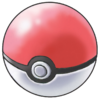
|
| Artwork from Red and Green |
Artwork by Ken Sugimori |
Sprites
| In-battle sprite in Generation II |
Sprite from Furret Frolic's instruction screen in Stadium 2 |
In-battle and Summary sprite from Generation III |
Summary sprite from Colosseum |
| Summary sprite from XD: Gale of Darkness |
Summary sprite from Generations IV and V |
In-battle sprite in Generation IV |
In-battle sprite in Generation V |
Models

|

|
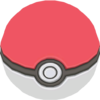
|
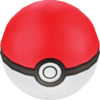
|
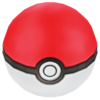
| |
| Model from Stadium |
Model from Stadium 2 |
Model from Furret Frolic in Stadium 2 |
In-battle model X, Y, Omega Ruby, Alpha Sapphire, Sun, Moon, Ultra Sun, and Ultra Moon |
Model from Let's Go, Pikachu! and Let's Go, Eevee! |
Model from Generation VIII |
In spin-off games
Pokémon Shuffle

|
This section is incomplete. Please feel free to edit this section to add missing information and complete it. |
Pokémon GO
Poké Balls can be used during wild Pokémon encounters to attempt to capture a wild Pokémon with a catch rate modifier of 1×.
Description
|
Acquisition
The player starts the game with 50 Poké Balls and is awarded additional Poké Balls when they level up to any level from 2 to 11.
Poké Balls can also be repeatable obtained by
- Spinning PokéStops or Gyms
- Field Research
- Opening a Gift
In addition, the player can purchase Poké Balls with PokéCoins in the Shop at the following rates:
Finally, Poké Balls can be included in limited-time Box deals.
In the Pokémon Trading Card Game series
In Pokémon Trading Card Game and Pokémon Card GB2: Here Comes Team GR!, there are no Poké Balls. However, the Poké Ball card is available in both games.
| Poké Ball (GB1) | Poké Ball (GB2) |
In the Pokémon Pinball series
In Pokémon Pinball and Pokémon Pinball: Ruby & Sapphire, the Poké Ball is the normal ball used in Pinball games since the beginning of the game. It has no bonus multiplier, but it can be upgraded into other types of Poké Ball that multiply bonus points.
| Sprite from Pinball |
Sprite from Pinball: Ruby & Sapphire |
Super Smash Bros. series
In the Super Smash Bros. series, Poké Balls mainly appear as items which a character can pick up and throw to release a random Pokémon. Most Pokémon will perform a direct attack against the characters on the stage, but some may have other effects. Like many other items, the Poké Balls also do damage simply by hitting other characters.
The Poké Ball also features in a couple of other ways in the Super Smash Bros. series. In Brawl, in The Subspace Emissary, Pokémon Trainer is shown to push the button on the Poké Ball to send out his Pokémon, a mechanic that has not been shown in the anime.
Trophy information
Super Smash Bros. Melee
These balls are used to catch and contain wild Pokémon. Most Pokémon must be weakened in some way before they can be caught, but once they're inside a Poké Ball, they enjoy their new home, since Poké Balls contain an environment specially designed for Pokémon comfort. Master Balls are the strongest type.
Super Smash Bros. Brawl
"An item used for capturing Pokémon and calling them out into battle. Pokémon live in these items which despite appearances, actually contain a wide, comfortable Pokémon-friendly world inside them. In Super Smash Bros., Pokémon give temporary support to who calls them out. You never know which you will get, but some are devastatingly powerful."
Super Smash Bros. for Nintendo 3DS/Wii U
NA: An item used to call out different Pokémon. Which Pokémon emerges is a mystery, but it will aid whoever threw the Poké Ball. Some of the Pokémon contained inside are extremely powerful and will really intensify the battle. It's definitely worth beating your opponents to these!
PAL: A ball holding one of any number of Pokémon just waiting to burst out and help you in battle. Which kind will it be? Well, that's a surprise, but whichever one it is, it'll definitely up the intensity of the battle! If you see one, make sure you're the one to grab it!
In the anime

In the main series
In the anime, the basic Poké Ball is the most commonly used of all varieties, with other varieties rarely being used at all, especially prior to the Sun & Moon series. The vast majority of Pokémon are shown to be stored in regular Poké Balls, to the point that large collections of Poké Balls are usually almost exclusively standard Poké Balls. Even Ash's Pikachu, the most prominent Pokémon in the anime which spends all of its time outside with Ash, has a plain Poké Ball that differs from others only by the small yellow lightning bolt symbol on it, as seen in Pokémon - I Choose You!. This could be due to the games not keeping a track of the Poké Ball that a Pokémon was caught in prior to Generation III, making the anime not showing Pokémon in non-standard Poké Balls concordant with the games.


In Pokémon Origins
Poké Balls were seen in every episode of Pokémon Origins, starting with the starter Pokémon's Poké Balls in File 1: Red. When Red started out as a Trainer, he typically caught and stored his Pokémon in Poké Balls. As he, his Pokémon, and the Pokémon around him grew stronger, he eventually started using Great Balls and Ultra Balls instead.
In Pokémon Generations
Regular Poké Balls were seen several times throughout Pokémon Generations. They first appeared in The Adventure, where Red caught a Pikachu with one.
In the manga
In The Electric Tale of Pikachu manga
In The Electric Tale of Pikachu, Poké Balls are numbered on the outside, on the button, so that a Trainer knows which member of their team they are sending into battle. Trainers must obtain a Pokémon Trainer's license before they are legally allowed to purchase Poké Balls.
It is also possible for a Pokémon to be placed inside a Poké Ball without it being owned by a Trainer. In Days of Gloom and Glory, Meowzie steals a Poké Ball from a shop and puts her kitten in it so that it will not be hurt by a flood affecting the city.
In the Pokémon Adventures manga
Poké Balls have been seen in Pokémon Adventures since the very beginning, first appearing in A Glimpse of the Glow. Like other Poké Balls in Pokémon Adventures, regular Poké Balls are semi-transparent from the top, allowing the Pokémon inside to be seen. Like in the anime, most Trainers keep their Pokémon in regular Poké Balls, although its variations have been seen more commonly in it than in the anime.
In the Pokémon Gotta Catch 'Em All manga
In Pokémon Gotta Catch 'Em All, Poké Balls are depicted as solid, with no visual identification as to which Poké Ball is which. In Special Chapter - Get Pikachu!, it is revealed that when Shu met Pikachu, Pikachu's Poké Ball had been abandoned in a forest because it was defective and it was causing Pikachu's electricity to be released throughout the surrounding area.
In the Pokémon Pocket Monsters manga
In Pokémon Pocket Monsters, Poké Balls are often shown as transparent to identify when a Pokémon is inside. They usually have their typical appearance from far away, suggesting that they may not always be transparent, or are only see-through from up close. Pokémon appear to be able to see the world outside of their Poké Balls, as shown in Bring Down the Powerful Opponent Onix!!, when Clefairy sees Pikachu inside his Poké Ball, and they talk to each other. In Introducing the Pokémon Clefairy!!, when Green is choosing Charmander as his starter Pokémon, he is shown to be able to pick up and lift Charmander directly from the Poké Ball without throwing it first.
Gallery
A Poké Ball in Ash & Pikachu
A Poké Ball in Be the Best! Pokémon B+W
A Poké Ball in How I Became a Pokémon Card
A Poké Ball in a movie adaptation
In the TCG
- Main article: Poké Ball (Jungle 64)
The Poké Ball was introduced as an Trainer card in the Pokémon Trading Card Game during the English Original Series (the Japanese Original Era). First released in the Jungle expansion, it was reprinted in the Japanese Hanada City Gym and Kuchiba City Gym Theme Decks. It was later reprinted in the EX Ruby & Sapphire expansion, with new artwork by K. Hoshiba and an updated effect. This print was used until the release of EX Unseen Forces, which featured new artwork by Shin-ichi Yoshikawa. This print was used throughout the rest EX Series, and the first part of the Diamond & Pearl Series, up until the release of Majestic Dawn expansion. This print featured new artwork by Ryo Ueda.
It was later reclassified in Japan as an Item card during the HeartGold & SoulSilver Series, though the English prints did not adopt this naming convention until the release of the Black & White expansion. The HeartGold & SoulSilver print featured new artwork by Hideaki Hakozaki, and the Japanese Battle Starter Decks featured yet another new illustration by Noriko Hotta. This card was released again in the Black & White expansion with new artwork by Yuri Umemura. This print was later released in the Boundaries Crossed expansion. This card was reprinted again during the XY Series in the English Kalos Starter Set with new artwork by 5ban Graphics. This print was later reprinted in the English XY Trainer Kit, and in the Generations expansion.
Poké Ball was reprinted again during the Sun & Moon Series as part of the Sun & Moon expansion with new artwork by Ryo Ueda. As of this print, when the player plays it, they flip a coin. If the coin shows heads, they may search their deck for a Pokémon, reveal it, and put it into their hand, shuffling their deck afterwards.
In other languages
| ||||||||||||||||||||||||||||||||||||||||||||||||||||||||||||||||||

|
This item article is part of Project ItemDex, a Bulbapedia project that aims to write comprehensive articles on all items. |






